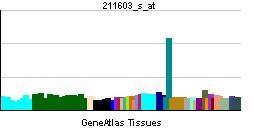ETV4
| Ets variant gene 4 (E1A enhancer binding protein, E1AF) | |||||||||||
|---|---|---|---|---|---|---|---|---|---|---|---|
| Identifiers | |||||||||||
| Symbols | ETV4 ; E1A-F; E1AF; PEA3; PEAS3 | ||||||||||
| External IDs | Template:OMIM5 Template:MGI HomoloGene: 1504 | ||||||||||
| |||||||||||
| RNA expression pattern | |||||||||||
 | |||||||||||
| More reference expression data | |||||||||||
| Orthologs | |||||||||||
| Template:GNF Ortholog box | |||||||||||
| Species | Human | Mouse | |||||||||
| Entrez | n/a | n/a | |||||||||
| Ensembl | n/a | n/a | |||||||||
| UniProt | n/a | n/a | |||||||||
| RefSeq (mRNA) | n/a | n/a | |||||||||
| RefSeq (protein) | n/a | n/a | |||||||||
| Location (UCSC) | n/a | n/a | |||||||||
| PubMed search | n/a | n/a | |||||||||
Ets variant gene 4 (E1A enhancer binding protein, E1AF), also known as ETV4, is a human gene.[1]
References
Further reading
- Friedman LS, Ostermeyer EA, Lynch ED; et al. (1995). "22 genes from chromosome 17q21: cloning, sequencing, and characterization of mutations in breast cancer families and tumors". Genomics. 25 (1): 256–63. PMID 7774926.
- Liu SH, Peng BH, Ma JT; et al. (1995). "Serum response element associated transcription factors in mouse embryos: serum response factor, YY1, and PEA3 factor". Dev. Genet. 16 (3): 229–40. doi:10.1002/dvg.1020160303. PMID 7796532.
- Friedman LS, Ostermeyer EA, Lynch ED; et al. (1995). "The search for BRCA1". Cancer Res. 54 (24): 6374–82. PMID 7987831.
- Higashino F, Yoshida K, Fujinaga Y; et al. (1993). "Isolation of a cDNA encoding the adenovirus E1A enhancer binding protein: a new human member of the ets oncogene family". Nucleic Acids Res. 21 (3): 547–53. PMID 8441666.
- Isobe M, Yamagishi F, Yoshida K; et al. (1996). "Assignment of the ets-related transcription factor E1A-F gene (ETV4) to human chromosome region 17q21". Genomics. 28 (2): 357–9. doi:10.1006/geno.1995.1158. PMID 8530053.
- Urano F, Umezawa A, Hong W; et al. (1996). "A novel chimera gene between EWS and E1A-F, encoding the adenovirus E1A enhancer-binding protein, in extraosseous Ewing's sarcoma". Biochem. Biophys. Res. Commun. 219 (2): 608–12. PMID 8605035.
- Coutte L, Monté D, Baert J, de Launoit Y (2000). "Genomic organization of the human e1af gene,a member of Ets transcription factors". Gene. 240 (1): 201–7. PMID 10564827.
- Mastrangelo T, Modena P, Tornielli S; et al. (2000). "A novel zinc finger gene is fused to EWS in small round cell tumor". Oncogene. 19 (33): 3799–804. doi:10.1038/sj.onc.1203762. PMID 10949935.
- Strausberg RL, Feingold EA, Grouse LH; et al. (2003). "Generation and initial analysis of more than 15,000 full-length human and mouse cDNA sequences". Proc. Natl. Acad. Sci. U.S.A. 99 (26): 16899–903. doi:10.1073/pnas.242603899. PMID 12477932.
- Davidson B, Goldberg I, Gotlieb WH; et al. (2004). "PEA3 is the second Ets family transcription factor involved in tumor progression in ovarian carcinoma". Clin. Cancer Res. 9 (4): 1412–9. PMID 12684413.
- Span PN, Manders P, Heuvel JJ; et al. (2004). "E1AF expression levels are not associated with prognosis in human breast cancer". Breast Cancer Res. Treat. 79 (1): 129–31. PMID 12779089.
- Anderson NL, Polanski M, Pieper R; et al. (2004). "The human plasma proteome: a nonredundant list developed by combination of four separate sources". Mol. Cell Proteomics. 3 (4): 311–26. doi:10.1074/mcp.M300127-MCP200. PMID 14718574.
- Liu Y, Borchert GL, Phang JM (2004). "Polyoma enhancer activator 3, an ets transcription factor, mediates the induction of cyclooxygenase-2 by nitric oxide in colorectal cancer cells". J. Biol. Chem. 279 (18): 18694–700. doi:10.1074/jbc.M308136200. PMID 14976201.
- Suzuki Y, Yamashita R, Shirota M; et al. (2004). "Sequence comparison of human and mouse genes reveals a homologous block structure in the promoter regions". Genome Res. 14 (9): 1711–8. doi:10.1101/gr.2435604. PMID 15342556.
- Davidson B, Goldberg I, Tell L; et al. (2004). "The clinical role of the PEA3 transcription factor in ovarian and breast carcinoma in effusions". Clin. Exp. Metastasis. 21 (3): 191–9. PMID 15387369.
- Fauquette V, Perrais M, Cerulis S; et al. (2005). "The antagonistic regulation of human MUC4 and ErbB-2 genes by the Ets protein PEA3 in pancreatic cancer cells: implications for the proliferation/differentiation balance in the cells". Biochem. J. 386 (Pt 1): 35–45. doi:10.1042/BJ20040706. PMID 15461591.
- Gerhard DS, Wagner L, Feingold EA; et al. (2004). "The status, quality, and expansion of the NIH full-length cDNA project: the Mammalian Gene Collection (MGC)". Genome Res. 14 (10B): 2121–7. doi:10.1101/gr.2596504. PMID 15489334.
- Zhu X, Jiang J, Shen H; et al. (2005). "Elevated beta1,4-galactosyltransferase I in highly metastatic human lung cancer cells. Identification of E1AF as important transcription activator". J. Biol. Chem. 280 (13): 12503–16. doi:10.1074/jbc.M413631200. PMID 15611127.
- Takahashi A, Higashino F, Aoyagi M; et al. (2005). "E1AF degradation by a ubiquitin-proteasome pathway". Biochem. Biophys. Res. Commun. 327 (2): 575–80. doi:10.1016/j.bbrc.2004.12.045. PMID 15629152.
- Nosho K, Yoshida M, Yamamoto H; et al. (2005). "Association of Ets-related transcriptional factor E1AF expression with overexpression of matrix metalloproteinases, COX-2 and iNOS in the early stage of colorectal carcinogenesis". Carcinogenesis. 26 (5): 892–9. doi:10.1093/carcin/bgi029. PMID 15695237.
External links
- ETV4+protein,+human at the US National Library of Medicine Medical Subject Headings (MeSH)
| This protein-related article is a stub. You can help Wikipedia by expanding it. |
This article incorporates text from the United States National Library of Medicine, which is in the public domain.